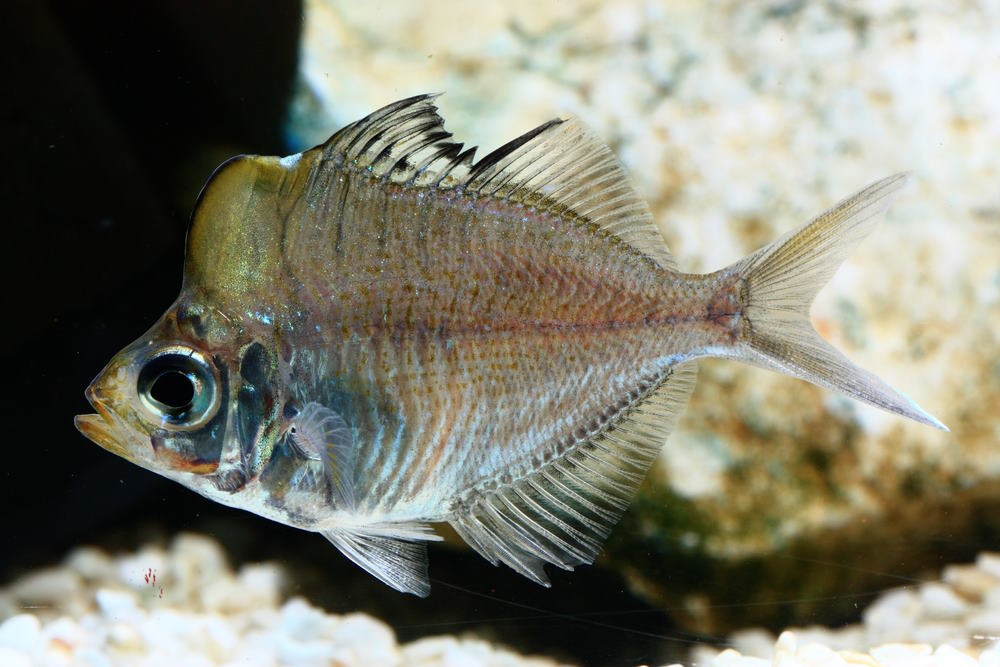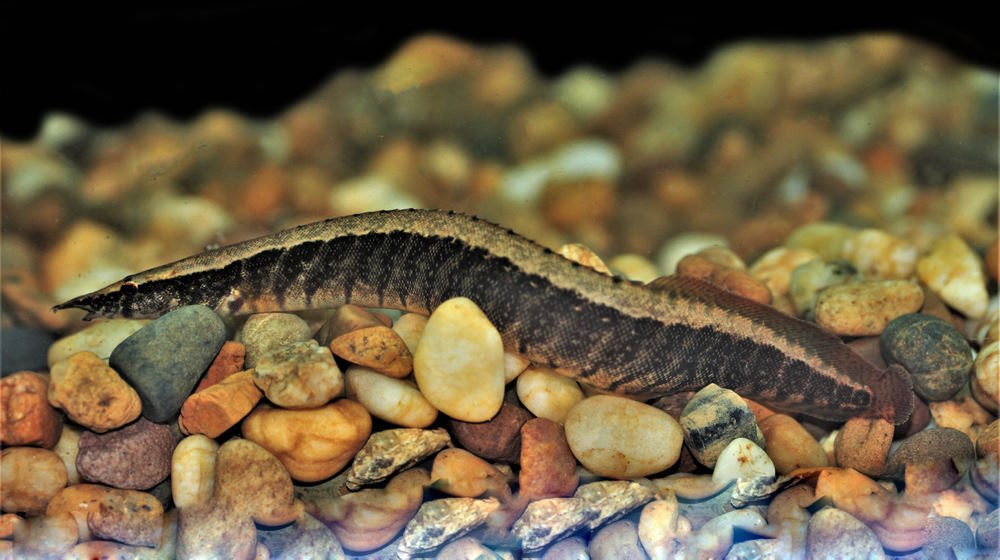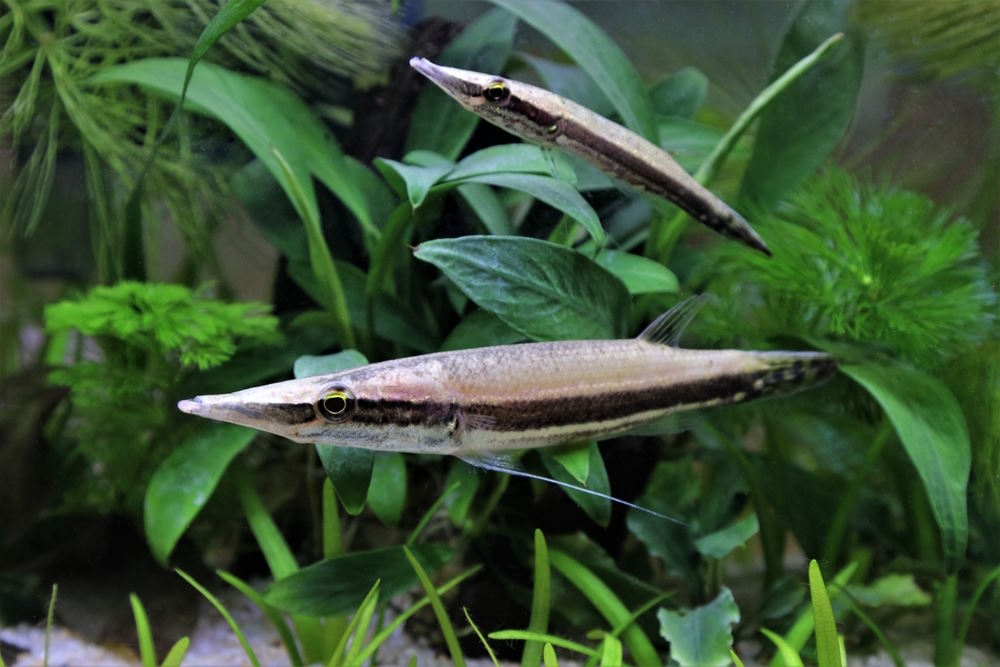Top 5 Oddball Fish for a 40-Gallon Aquarium
If you’re looking for something rare or unusual, oddball species are a great way to spice up your fish tank. Specifically, the 40-gallon breeder aquarium is very versatile and really opens up the world to medium-sized animals. Learn about 5 fantastical aquatic pets that are sure to make you stop and stare.
1. Humphead Glassfish

Parambassis pulcinella
The humphead glassfish is a bizarre sight to behold. Imagine a 3- to 4-inch (8–10 cm) schooling fish with big, googly eyes and a translucent nuchal hump on its head that is scaleless and has a black edge running down the front. Its deep-bodied, silvery body is covered in vertical, armor-like ridges, and the fins are mostly clear with some faint black markings. There are several species of glassfish, some of which require brackish water, but this species is found in the freshwater streams and rivers of Southeast Asia. They do prefer alkaline pH from 7.0–8.0, harder water, and temperatures of 74–81°F (23–27°C). Humphead glassfish are safe with aquarium plants, can live in stronger currents with a power head, and get along with other boisterous fish that are too big to eat — like loaches and giant danios. Get a school of at least 6 to 8 so they won’t be too nervous, and feed them a wide variety of different omnivorous fish foods like flakes, freeze-dried foods, and frozen bloodworms.
2. Marbled Headstander

Abramites hypselonotus
This 5-inch (13 cm) oddball characin is known for its eye-catching appearance and unusual behavior. They come from a group of fish called headstanders because they tend to swim with their heads angled downwards while constantly grazing off the ground and other surfaces. They have a pointy face and high arch on their upper back — which gives them the common name of “high-backed headstander.” Their light-colored body is covered in vertical, black marbling, which creates a strikingly bold pattern. This schooling fish enjoys being in a big group of its own species and is generally found in the lower half of the aquarium.
Because they’re found in different river basins all over South America, they are quite hardy and can live in a broad range of water parameters, such as pH of 6.0–7.5, temperatures between 72–82°F (22–28°C), and soft to hard GH levels. Like the Florida flagfish, they are known to pick at hair algae and delicate plants, so you may want to try tougher aquatic plants like java fern and terrestrial plants like pothos. They also may fin nip slow-moving, long-finned fish out of curiosity, so keep them with moderate-sized tank mates like Geophagus cichlids, bigger tetras, and catfish. Offer your marbled headstanders an omnivorous diet with higher amounts of plant and algae matter that includes foods such as spirulina flakes, Repashy Soilent Green, and blanched vegetables like sliced zucchini.
3. Half-Banded Spiny Eel

Macrognathus circumcinctus
Most freshwater eel-like species, like the zig zag eel and fire eel, are much too big for a 40-gallon aquarium. However, this “dwarf eel” is relatively small by comparison, ranging from 8 inches (20 cm) in captivity to 11 inches (29 cm) in the wild. Similar to its larger cousins, it has a pointy face like a loach and an elongated, muscular body. However, the half-banded spiny eel has a very distinct snakeskin pattern consisting of dark, vertical (or straightly slanted) banding that stops about halfway up the body. As with most eels, they are considered to be an intermediate level pet because of their preference for meaty live and frozen foods — like bloodworms, brine shrimp, mysis shrimp, earthworms, and diced fish fillet. However, since they are accustomed to the seasonal monsoons of Southeast Asia, they are relatively hardy and can withstand a wide range of water parameters, such as pH levels of 6.5–7.8, 75–82°F (24–28° C), and soft to moderate hardness.
While they are a little more outgoing compared to other eel-like species, this bottom dweller is still nocturnal and likes to hide during the daytime. Keep the lighting dim, and make sure to have a tight-fitting lid with no openings for them to escape from. Add PVC pipes and caves for them to take cover, and consider using sand substrate so they can partially bury themselves. Because of their habit of digging and burrowing, avoid rooted aquarium plants and instead use epiphytes (e.g., anubias and java fern) and floating plants for extra shade. Also, place all heavy rocks and decorations directly on the glass (or acrylic) bottom of the tank before adding substrate to prevent them from being dug up and falling on the eel.
4. Peppermint Pikehead

Luciocephalus aura
The peppermint or green-spotted pikehead is actually a labyrinth fish and relative of gouramis that is capable of gulping air from the surface, allowing it to live in low oxygen environments. This 3.5- to 4-inch (9–10 cm) ambush predator has a pointy face, tan body, and dark horizontal stripe covered in shiny green dots. They can often be found hovering motionless in the water, waiting for live foods like ghost shrimp and small fish to pass by. They are generally recommended for experienced fishkeepers because of their strong desire for eating live animals, but some hobbyists have successfully trained them to eat frozen or freeze-dried foods. If you are unable to wean them, be prepared to raise your own colony of livebearers, convict cichlids, or cherry shrimp to make sure you have a constant source of disease-free food.
The peppermint pikehead comes from the tropical rainforest swamps of Indonesia and prefers acidic pH from 6.0–7.0, soft to moderate hardness, and 72–79°F (22–26°C). This schooling fish is relatively peaceful and can live in a community aquarium with other soft water animals that are too big to be eaten. Just be aware that their jaw can protrude and expand to swallow fish that are almost half their size. These huge mouths are also used to hold their eggs, much like mouthbrooding betta fish. After mating, the female deposits her eggs on the ground, and the male gently sucks them up with his mouth. He will hold them in there for about a month without eating until the babies have hatched and are free swimming.
5. Axolotl

Ambystoma mexicanum
A fun “wet pet” that has gained popularity from the video game Minecraft is the axolotl. It is an entirely aquatic salamander that never loses its external gills and is often studied by researchers because of its ability to regrow almost any body part. The axolotl has a length of 9–12 inches (23–31 cm) and comes in many colors — such as wild type (dark brownish-gray), leucistic, melanoid, and albino. Some of them have been genetically modified by scientists with the green fluorescent protein (GFP), which causes them to glow green under blue or black lighting. This trait can be passed on through breeding, which is why it is commonly available in the pet trade.
Although they tend to swim around more during childhood, adult axolotls are ambush predators that spend most of their time hanging out at the bottom of the tank, waiting for food to pass by. Despite their sedentary ways, you only want to keep two or three individuals in a 40-gallon aquarium because they are messy eaters and create lots of waste. To simulate the high-altitude lakes in Mexico where they come from, aim for cooler temperatures of 60–68°F (15–20°C), pH between 6.5–8.0 pH, and harder water. (See our article for more details on how to cool the water in your aquarium.) They also appreciate slower flow, low lighting, and plants that can’t be uprooted (e.g., anubias, java fern, floating plants, and pothos) to help purify the water. There is a lot of debate on what substrate to use since axolotls have been known to swallow small rocks, so do your research to see if you want to use sand, tile, a bare bottom tank, or other options.
As for tank mates, most hobbyists keep them in a species-only tank since it can be hard to find other animals that prefer cooler waters, won’t get eaten, and also won’t nibble on the axolotl’s frilly gills. (If you keep multiple axolotls together, make sure they are all similar in size because they will opportunistically eat anything that fits in their mouth, including their own kind.) Some people have kept axolotls with dwarf shrimp or white cloud mountain minnows, as long as you’re okay with them becoming an occasional snack. They enjoy eating meaty foods, such as sinking carnivore pellets, live worms, frozen bloodworms, and brine shrimp.
If you love oddball animals but are looking for something that can fit in a smaller-sized aquarium, check out our favorite unusual species for 10-gallon, 20-gallon, and 30-gallon fish tanks. While Aquarium Co-Op does not ship live fish, see our list of preferred online vendors to find out what oddball species they have in stock.




